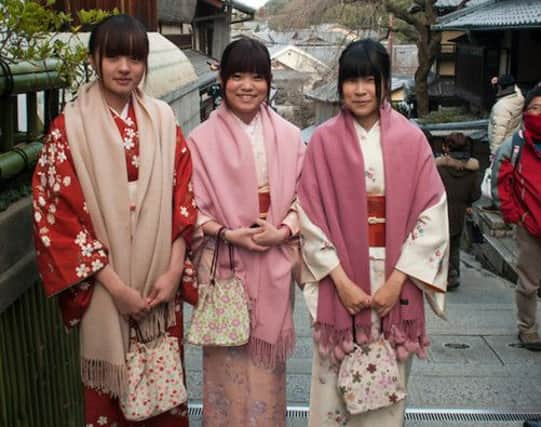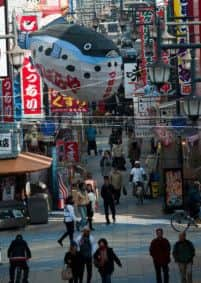Travel: Japan


Since then, a lifelong love of comics and graphic illustration, coupled with a great interest in the oriental martial arts and being an avid consumer of their technology, has added to this fascination. So it’s little wonder that when I was invited on a trip to Japan my fingers flew faster than a sweeping katana blade across the keyboard to accept.
Is it possible that a whole national identity can be affected by the regular placement of cute cartoons and imaginary icons? From billboards to books, everywhere I looked in Japan seemed to have a graphic character selling or championing a cause.
Advertisement
Hide AdInformation signs at a hot spa resort? Show it with manga. Inconvenienced by roadworks? Say it with a manga frog. Small figurines of Hello Kitty or large statues of manga superheroes are interspersed with regional mascots such as Sento-kun the Buddha boy. Translated literally as “whimsical sketches”, manga cartoons pervade Japanese culture, and my family and I wondered if the happy attitude and general gaiety of the people could be attributed in part to the artform.


On our first day a visit to the Kyoto International Manga Museum certainly opened our eyes to the breadth of the genre. Set in a former primary school in Kyoto with an astroturf reading area the size of a football pitch out front, the museum is testament to the nation’s fondness for cartoons. Lining the walls are 50,000 small paperback periodicals, with a further 250,000 tucked away in storage. Outlining the history of manga from early wood-block character prints up to the staggering opening week sales of 3.8 million copies for the top-selling quarterly One Piece, it really is a haven for fans of the genre.
But enough of my manga obsession. Our trip encompassed the region of Kansai in the south of Japan’s main island of Honshu and the first stop was the ancient capital of Kyoto. It’s all about Zen, shrines and temples, so it’s no surprise the city has a staggering 17 Unesco world heritage sites.
Twinned with Edinburgh since 1994, it has many similarities, but a major difference is its geography, being situated on a flat plain.
A real standout, the Fushimi Inari shrine sits on the edge of the plain, where 10,000 vermilion Torii, or Shinto gateways, wind their way into the mountain. It attracted 2.5 million visitors in the New Year week alone. Luckily, our day allowed time for a spot of Zen meditation at the Shunkoin Temple led by the Reverend Takafumi Kawakami, a tenth-generation Shinto monk who happens to have a neuroscience degree from MIT. A brilliant 15-minute session blew away any residual cobwebs of long-distance travel and gave me pointers to maintain a spot of calm in my hectic home life.
After Kyoto, at my son’s behest we made a brief station detour to photograph the Shinkansen bullet trains before travelling on to Nara, a small city where the deer are as revered as the sacred cows of India and roam the parks in their thousands. They brought a real sense of serenity as we walked in the grounds of the Nara shrine with its lanterns and wind chimes. It was truly beautiful.
Advertisement
Hide AdThe pace was to pick up as we moved on to another world heritage site, the Todaiji Temple, where the Daibutsuden or Great Hall was built on a grand scale in 747. It’s been fire-ravaged in the past 1,000 years but even at two-thirds the size of the original it’s still the largest wooden building in the world, purpose-built to house the 15-metre bronze Buddha, also the largest in the world.
Moving on into the city, we were given a taste of traditional Japanese crafts, such as ink blocking and high-energy hammering of mochi for sweet rice cakes. I wasn’t too keen on the cakes, or the taste of the wagashi confectionary we made either, although I enjoyed the quiet pleasure of making them with a master of the art.
Advertisement
Hide AdBy contrast, the exquisite creations of sushi and sashimi, tofu and shaped vegetables, were delicious examples of Japanese cuisine, but I must confess that by the time we left Nara, all I wanted was a steak. It was fortunate, then, that a tiring train journey followed by the hustle and bustle of central Osaka led us straight into what seemed the best restaurant ever: President Chibo, where the melt-in-your-mouth wagyu steak and the Osaka speciality okonomiyaki, all cooked in front of us, were a dream come true.
Osaka is the cheese to Kyoto’s chalk. Known as the working heart of Kansai, Osaka surely rivals Tokyo as the archetypal urban phenomenon.
Our last day began at a multi-storey hot spring bath resort, segregated as the Japanese prefer, and kitsch is the word. Each floor themed on a different continent, it was like something from an eccentric Hollywood mansion and the sleeping bodies on couches waiting to gain access only added to the spectacle.
Our culture for the day took us to Osaka Castle, which dominates the centre of the city and is very much a museum since it was gutted by fire in the Second World War.
But it was the busy streets that were most alluring, and a wish to sample the nightlife drew us to a tiny basement bar crammed with Rolling Stones memorabilia, reminiscent of Lost In Translation, where the owner made us welcome even if we did suspect he hadn’t had a western client for a decade. Domo arigato Nippon. I’ll certainly be back!